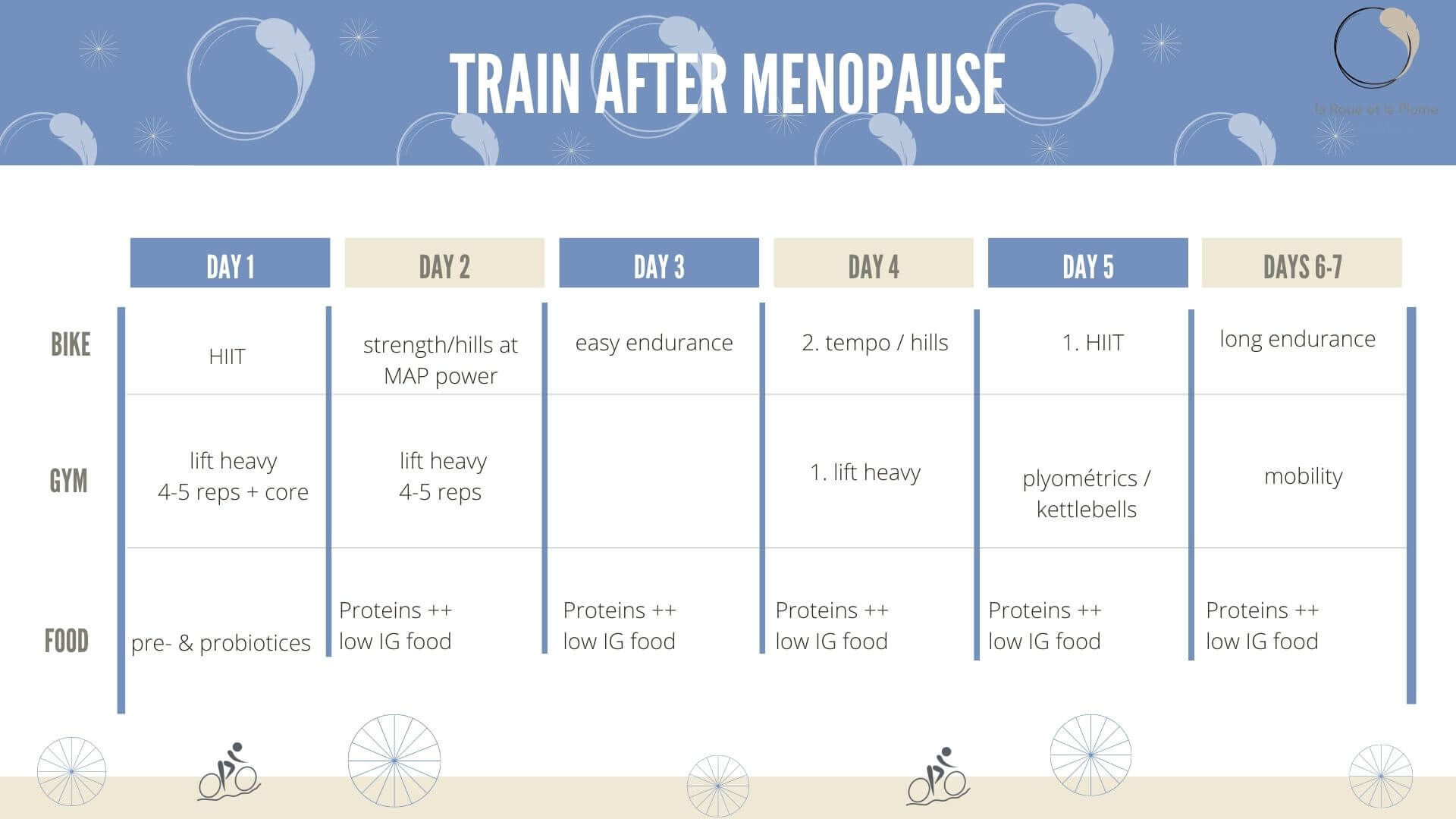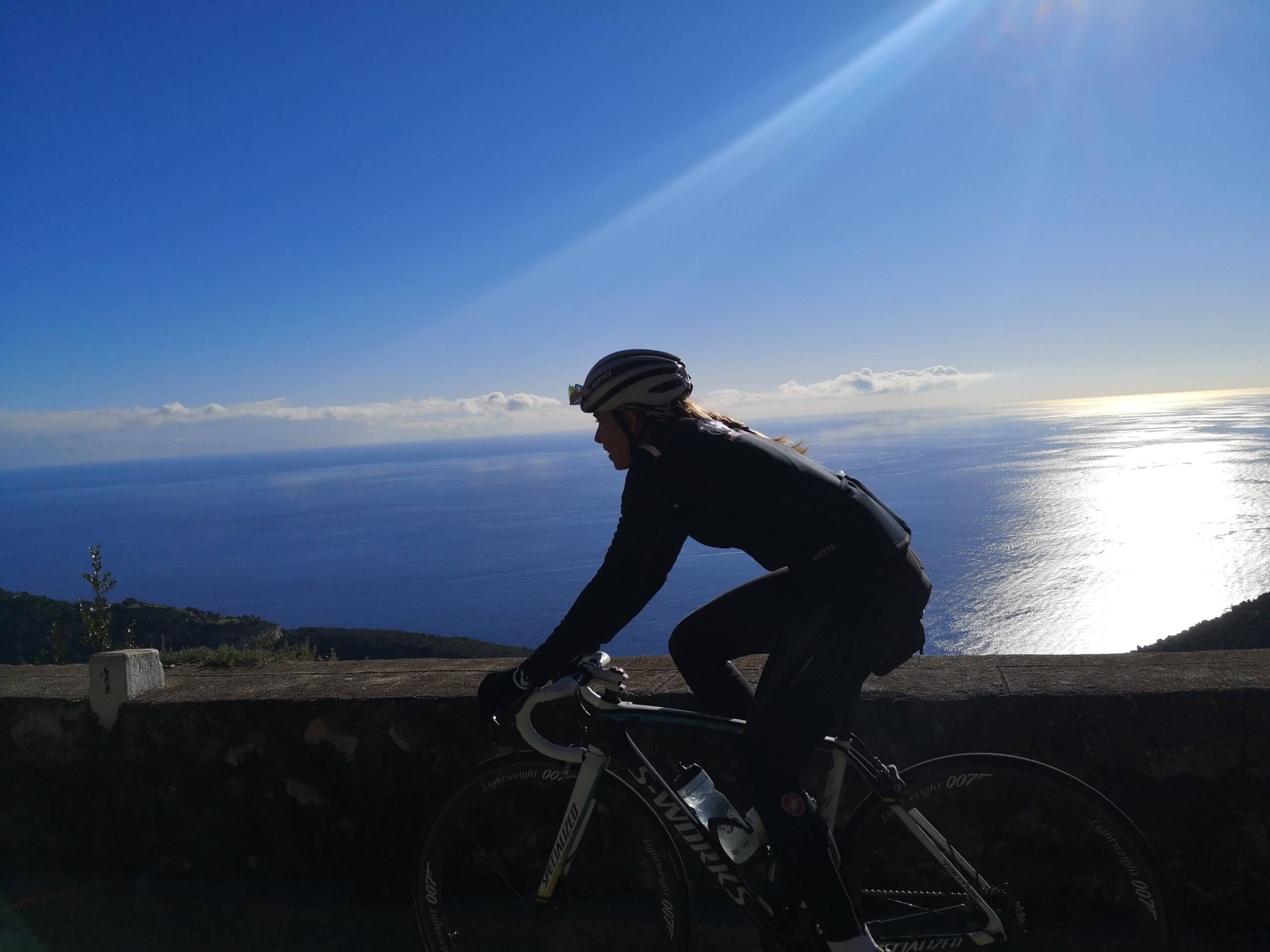Menopause is the start of a totally different phase of a woman’s life, where the body becomes so different that many aspects must evole in the daily life of menopausal women, including their training. Menopause means that the ovaries stop working, and thus that the ovarian hormones esotrogenes and progesterone are not produced like they were since puberty. We have already seen how these hormones impact the way women respond to training; not producing them anymore means that we need to introduce external stimulations to replace them through our training. Hormones which had cycle-like variations since puberty are now in very low concentrations : the response of the body to training is different, metabolism is different, mood and emotions are different, sleep is different, it’s a new life !
Menopause is not the end of athletic life
Menopause is often associated with a change in body composition with a decrease of muscle mass and an increase in fat. Heavier and with less muscle means, for any endurance athletes, a decline in performance.
Most of the time, this is what happens to menopausal women, and not because it is a fatality, but simply because we don’t know the tools to adapt the every day life to the new way the menopausal body works, so we do the same thing as before, even though the machine is completely different. The training, food or recovery which used to work before is not going to work in the same way, because of the changes in these powerful hormonal messengers !
The major changes happening with menopause and with a link to endurance training are
- changes in how force and power are produced
- changes in how nutrients are being absorbed and used (metabolism, and thus daily energy expenditure and body composition)
- changes in recovery (especially sleeping)
- changes in the body’s reactions to thirst and sweat.
By using these changes as incentives to adapt the way to train, eat, recover and sleep, there is no reason a menopausal woman wouldn’t be able to enjoy her sport and keep performing ! On the other hand, dismissing these changes and keeping the former methods will not elicit progress or positive changes in the athlete ! It’s all about working with your body the way it is.
1. Menopause : train differently
Head to the gym: strength training becomes more important than ever !
To produce muscle mass, you need the synthesis of muscle proteins to be more important that the destruction of these proteins. The muscle protein synthesis (MPS) is stimulated both by resistance/strength training and by nutrient (protein) intake through different but convergent mechanisms (Biolo et al., 1995). These mechanisms are supported by oestrogens in the pre-menopausal women with natural cycles or non hormonal contraception. During menopause, without oestrogens, it is important to reinforce the external training stimuli in order to maintain or improve lean muscle mass. Nothing more efiicient to achieve this than resistance/strength workouts which increase MPS by 40% to 150% – under the additional condition that the athlete brin an external source of proteins to the body through food intake- (Chesley et al., 1992)!
Strength sessions will not make you look like a bodybuilder ! It is the only way to maintain the muscles you already have, and the force you can develop. Without that, no power and no speed ! Lifting heavy is what Dr Stacy Sims recommands doing 2 to 3 times a week.
Here are some menopause adjusted recommendations for strength training
- 2 to 3 sets of 10 repetitions (you can lift the weight 10 times but the last 2 are challenging to realise)
- as many repetitions as possible for a set duration
- 2 to 3 strength sessions a week using the above recommandations
- vary exercices regularly (change every 2-3 weeks in order to work out all muscle groups)
- and keep working on your core !
Endurance for fun, high intensity for training
The second modification of training to include in your menopause routine is based on high intensity training : on the bike, running or doing plyometric jumps. In order to have power, you need your muscles to be able to contract rapidly (and forcefully). This ability decreases with age (for men as well by the way) so you need to stimulate it with bouts of exercices where your muscles have to contract very briefly and powerfully : plyometrics is all you need (jumping rope, burpes, jump squats, etc.) !
Good news is, there’s a double win to this type of sessions : they will also allow you to stimulate your bone mineral density, as well as limiting the tendency of the body to lean towards insuline resistance, a real risk for menopausal women.
On the bike, long slow ride will not induce important physiological adaptations anymore so you don’t need them to make progress anymore, they are just for your own satisfaction. Progress will be induced by high intensity and strength training.
Weekly schedule example

2. Eat what your body needs after menopause
We already knew in 1966 that post menopausal female bodies can’t metabolise fructose. For women before menopause, it seems that their bodies is able to store the excess energy from fructose as sub-cutaneous fat (especially in the hips and thighs), whereas the post-menopausal body doesn’t seem to be able to do so : thus, the fatty acids stay in the gut and blood, leading to high triglycerides concentrations and more insulin resistance. Compared to before menopause, less fructose is converted into glucose in order to be available and used for energy production during physical exercices. It is not only about not having fructose as a source of fuel anymore, it is also that all the non-metabolised fructose will wreak havoc on the whole metabolism, with unenjoyable gastro-intestinal tract issues : make sure your energy drinks, foods, bars and gels don’t have too much fructose in them !
With insulin resistance settling in, the food glycemic index becomes even more important than ever before for the post menopausal body : eating food with low glycemic index is more than a priority, it is an important step to support the body ! It is a different kind of training than the workouts you do : you are trying to support and work with your body from the inside out.
Last but not least, protein intake is of the utmost importance to maintain muscle mass. What triggers muscle growth is both resistance training and protein intake : both aspects are essentials. In a post menopausal body where oestrogens are not present to stimulate muscle growth, it is thus important to have a food intake allowing the body to get enough proteins (especially the amino acid leucin) so that your workouts actually lead to muscle growth. On top of that, timing of your protein intake is key, and Dr Sims reinforces the importance of eating your proteins within 30 minutes of the end of your workout.
3. Menopause : train yourself to recover better
I will not get tired of repeating it : progress is the combination of stress (training) + recovery/regeneration. One without the other will not lead to long term progress After menopause, the body doesn’t react to food and training in the same way, it doesn’t recover in the same way either. You can put strategies in place in order to increase your recovery : timing of protein intake as we explained above, and sleep.
It is harder to get a quality sleep in sufficient quantities after menopause : both sexual hormones (oestrogens and progesterone) help to fall asleep (sedative effect of progesterone) or to stay asleep and have a deep sleep (oestrogens increase the time you sleep in rEM sleep and decrease the number of times you wake up at night). A third hormone, melatonin (which regulates our wake/sleep cycles) is not produced in the same way as before the menopause, making sleep a different thing : sleep is going to be lighter, leading to less recovery and you’ll be more prone to difficulties falling asleep and night sweats.
Everything you’ve heard on how to sleep better will help you here, and there is no magic formula than simply not adding stress to the already trickier sleep situation : believe you can find your way of resting and sleeping, don’t be afraid of short power naps, keep your bedroom fresh and cool, go to bed at around the same time every day, avoid coffee and alcohol to limit the risk of night sweats. It is as important to get a sleep routine than to have a training routine !
4. Hydrate hydrate hydrate
Oestrogens are key regulators of our nervous system and of the regulation of stress hormones like cortisol, epinephrine, norepinephrine. Without oestrogens, the body after menopause will be less able to mitigate stress factors such as temperature variations : more hot flashes than before and even more in the heat.
Research has shown that after menopause women are less likely to sweat and to feel thirsty. But often they also have a higher core temperature compared to before menopause ! This is the deadly perfect combo for dehydration : it is thus of the utmost importance to have proper hydration strategies (even if you don’t feel thirsty !), like this recipe from Eat. Race. Win. : for a 50mL bottle, use 1/2 lemon juice, 1/16 tbsp salt and 1 tsp maple syrup. Potassium from lemon and sodium from salt will help the water molecules to cross the digestive walls and get into the plasma, which is harder for water to do on its own (more on this subject here). Pre-cooling before a warm event or ride will also help (drink a cold drink with electrolytes and no sugar for example).






